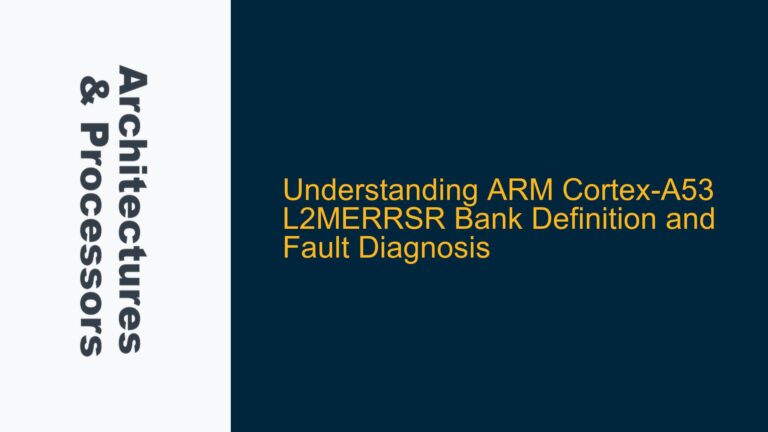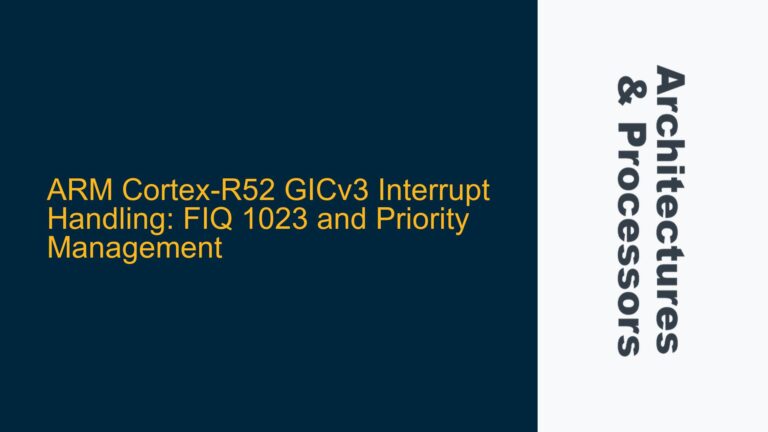SAMD21 Standby Sleep Mode Configuration and Wake-Up Timing Challenges
The SAMD21 microcontroller, based on the ARM Cortex-M0+ architecture, is widely used in low-power embedded applications due to its efficient power management capabilities. One of the key features of the SAMD21 is its ability to enter low-power modes, such as Standby mode, which significantly reduces power consumption by shutting down most of the microcontroller’s peripherals and core logic. However, configuring the SAMD21 to enter Standby mode and wake up after a specific time interval can be challenging, especially when integrating with higher-level frameworks like Arduino.
The core issue revolves around correctly configuring the SAMD21’s power management system, including the Power Manager (PM) and Real-Time Counter (RTC) peripherals, to ensure reliable entry into Standby mode and precise wake-up timing. The SAMD21’s Standby mode is designed to minimize power consumption by disabling the high-frequency clock sources, including the main CPU clock, and retaining only the low-power RTC for timing purposes. However, improper configuration of the RTC or failure to handle the wake-up sequence correctly can lead to issues such as failure to enter Standby mode, premature wake-ups, or incorrect wake-up timing.
The SAMD21’s RTC is a critical component in this process, as it provides the timing reference for the wake-up interval. The RTC can be clocked by either an internal 32.768 kHz oscillator or an external crystal, depending on the application’s accuracy and power requirements. The RTC’s clock source must be carefully selected and configured to ensure accurate timing during Standby mode. Additionally, the SAMD21’s interrupt system must be properly configured to handle the RTC’s wake-up interrupt and transition the microcontroller from Standby mode back to active mode.
Misconfigured RTC Clock Source and Interrupt Handling
One of the primary causes of issues with SAMD21 Standby mode and timed wake-ups is the misconfiguration of the RTC clock source. The RTC’s accuracy and reliability depend heavily on the selected clock source. If the internal 32.768 kHz oscillator is used, it is essential to ensure that it is calibrated correctly, as variations in temperature and supply voltage can affect its frequency. Alternatively, if an external crystal is used, the crystal’s load capacitance and startup time must be considered to ensure stable operation.
Another common cause of issues is improper handling of the RTC interrupt. The SAMD21’s RTC generates an interrupt when the configured wake-up time is reached, signaling the microcontroller to exit Standby mode. However, if the interrupt is not enabled or prioritized correctly, the SAMD21 may fail to wake up or may experience delays in transitioning to active mode. Additionally, the interrupt service routine (ISR) must be carefully implemented to handle the wake-up event and reconfigure the microcontroller’s clocks and peripherals as needed.
The SAMD21’s power management system also plays a crucial role in the transition between Standby and active modes. The Power Manager (PM) controls the clock distribution and power domains within the microcontroller, and any misconfiguration of the PM can lead to issues such as incomplete entry into Standby mode or failure to restore the correct clock configuration upon wake-up. For example, if the high-frequency clock sources are not disabled before entering Standby mode, the microcontroller may not achieve the expected power savings. Similarly, if the clocks are not restored correctly upon wake-up, the SAMD21 may not function as intended.
Configuring RTC Clock Source, Interrupts, and Power Management for Reliable Standby Mode Operation
To ensure reliable operation of the SAMD21 in Standby mode with timed wake-ups, a systematic approach to configuring the RTC clock source, interrupts, and power management is required. The following steps outline the key considerations and best practices for achieving this:
First, the RTC clock source must be selected and configured based on the application’s accuracy and power requirements. If the internal 32.768 kHz oscillator is used, it is recommended to calibrate it using the SAMD21’s built-in calibration mechanism. This involves measuring the oscillator’s frequency under different conditions and adjusting the calibration register to compensate for any deviations. If an external crystal is used, the crystal’s specifications must be carefully matched to the SAMD21’s requirements, and the load capacitance must be adjusted to ensure stable operation.
Next, the RTC must be configured to generate an interrupt at the desired wake-up interval. This involves setting the RTC’s counter value and compare register to the appropriate values based on the selected clock source and desired wake-up time. The RTC interrupt must be enabled and prioritized in the SAMD21’s nested vectored interrupt controller (NVIC) to ensure that it is handled promptly when the wake-up time is reached. The interrupt service routine (ISR) must be implemented to handle the wake-up event, including reconfiguring the microcontroller’s clocks and peripherals as needed.
The SAMD21’s power management system must also be configured to support the transition between Standby and active modes. This involves disabling the high-frequency clock sources before entering Standby mode to minimize power consumption. The Power Manager (PM) must be configured to control the clock distribution and power domains, ensuring that the microcontroller enters Standby mode correctly and restores the correct clock configuration upon wake-up. The PM’s sleep modes must be carefully selected based on the application’s requirements, with Standby mode being the most power-efficient option for long sleep intervals.
Finally, the SAMD21’s wake-up sequence must be carefully managed to ensure a smooth transition from Standby mode back to active mode. This includes handling any pending interrupts, reinitializing the microcontroller’s peripherals, and restoring the system state as needed. The wake-up sequence must be tested and validated under different conditions to ensure reliable operation.
By following these steps and best practices, the SAMD21 can be configured to enter Standby mode and wake up after a specific time interval reliably and efficiently. This approach ensures that the microcontroller achieves the desired power savings while maintaining accurate timing and reliable operation.
Detailed Configuration Steps for SAMD21 Standby Mode and Timed Wake-Up
To provide a more detailed guide, let’s break down the configuration steps for the SAMD21’s Standby mode and timed wake-up into specific actions:
RTC Clock Source Configuration
The RTC clock source is the foundation of the timed wake-up functionality. The SAMD21 offers two primary options for the RTC clock source: the internal 32.768 kHz oscillator and an external 32.768 kHz crystal. Each option has its advantages and considerations.
Internal 32.768 kHz Oscillator:
- Enable the internal oscillator by setting the appropriate bit in the OSC32KCTRL register.
- Calibrate the oscillator using the OSC32KCTRL calibration register. This involves measuring the oscillator’s frequency under different conditions and adjusting the calibration value to compensate for any deviations.
- Ensure that the oscillator is stable before proceeding with RTC configuration. This may involve waiting for the oscillator’s startup time, which can be several milliseconds.
External 32.768 kHz Crystal:
- Connect the external crystal to the SAMD21’s XIN32 and XOUT32 pins, ensuring that the crystal’s specifications match the microcontroller’s requirements.
- Configure the load capacitance for the crystal by setting the appropriate bits in the OSC32KCTRL register. The load capacitance must be adjusted based on the crystal’s specifications to ensure stable operation.
- Enable the external crystal by setting the appropriate bit in the OSC32KCTRL register.
- Wait for the crystal to stabilize before proceeding with RTC configuration. This may involve waiting for the crystal’s startup time, which can be several milliseconds.
RTC Configuration
Once the RTC clock source is configured, the RTC itself must be set up to generate an interrupt at the desired wake-up interval.
- Initialize the RTC by setting the appropriate mode in the RTC_MODE0 or RTC_MODE1 register. For timed wake-ups, RTC_MODE0 (32-bit counter mode) is typically used.
- Set the RTC’s counter value to zero by writing to the RTC_COUNT register.
- Configure the RTC’s compare register (RTC_COMP) to the desired wake-up interval. The value in the compare register is compared to the counter value, and when they match, an interrupt is generated.
- Enable the RTC interrupt by setting the appropriate bit in the RTC_INTENSET register. The interrupt must be enabled in the NVIC as well, with the appropriate priority level.
Power Management Configuration
The SAMD21’s power management system must be configured to support the transition between Standby and active modes.
- Disable the high-frequency clock sources (e.g., the main CPU clock) by setting the appropriate bits in the PM_SLEEPCFG register. This ensures that the microcontroller enters Standby mode with minimal power consumption.
- Configure the Power Manager (PM) to control the clock distribution and power domains. This involves setting the appropriate bits in the PM_CTRL and PM_SLEEPCFG registers to ensure that the microcontroller enters Standby mode correctly and restores the correct clock configuration upon wake-up.
- Select the appropriate sleep mode in the PM_SLEEPCFG register. For long sleep intervals, Standby mode (SLEEPCFG_SLEEPMODE_STANDBY) is the most power-efficient option.
Wake-Up Sequence
The wake-up sequence must be carefully managed to ensure a smooth transition from Standby mode back to active mode.
- Implement the RTC interrupt service routine (ISR) to handle the wake-up event. The ISR must clear the RTC interrupt flag and reconfigure the microcontroller’s clocks and peripherals as needed.
- Reinitialize the SAMD21’s peripherals and restore the system state as needed. This may involve reconfiguring the clocks, enabling peripherals, and restoring any saved context.
- Test and validate the wake-up sequence under different conditions to ensure reliable operation. This includes testing with different wake-up intervals, varying temperatures, and different power supply conditions.
Example Code Snippet
Below is an example code snippet demonstrating the configuration of the SAMD21’s RTC and power management system for Standby mode and timed wake-up:
#include <samd21.h>
void configureRTC() {
// Enable the internal 32.768 kHz oscillator
OSC32KCTRL->OSC32K.reg = OSC32KCTRL_OSC32K_ENABLE | OSC32KCTRL_OSC32K_EN32K | OSC32KCTRL_OSC32K_CALIB(0x7F);
// Wait for the oscillator to stabilize
while (!(OSC32KCTRL->STATUS.reg & OSC32KCTRL_STATUS_OSC32KRDY));
// Configure the RTC in 32-bit counter mode
RTC->MODE0.CTRL.reg = RTC_MODE0_CTRL_MODE(0) | RTC_MODE0_CTRL_ENABLE;
// Set the RTC counter to zero
RTC->MODE0.COUNT.reg = 0;
// Set the RTC compare value for 10-second wake-up interval
RTC->MODE0.COMP[0].reg = 327680; // 32768 * 10
// Enable the RTC compare interrupt
RTC->MODE0.INTENSET.reg = RTC_MODE0_INTENSET_CMP0;
// Enable the RTC interrupt in the NVIC
NVIC_EnableIRQ(RTC_IRQn);
}
void enterStandbyMode() {
// Disable the high-frequency clock sources
PM->SLEEPCFG.reg = PM_SLEEPCFG_SLEEPMODE_STANDBY;
// Enter Standby mode
__WFI();
}
void RTC_Handler() {
// Clear the RTC interrupt flag
RTC->MODE0.INTFLAG.reg = RTC_MODE0_INTFLAG_CMP0;
// Reinitialize the system clocks and peripherals
SystemInit();
}
int main() {
// Configure the RTC for timed wake-up
configureRTC();
// Enter Standby mode
enterStandbyMode();
// The microcontroller will wake up after 10 seconds and execute the RTC_Handler
while (1) {
// Main application loop
}
}
This code snippet demonstrates the basic configuration of the SAMD21’s RTC and power management system for Standby mode and timed wake-up. The configureRTC() function sets up the RTC with a 10-second wake-up interval, while the enterStandbyMode() function configures the power management system and enters Standby mode. The RTC_Handler() function handles the wake-up event and reinitializes the system clocks and peripherals.
Conclusion
Configuring the SAMD21 microcontroller for low-power operation with timed wake-ups involves careful consideration of the RTC clock source, interrupt handling, and power management system. By following the detailed steps outlined in this guide, developers can ensure reliable and efficient operation of the SAMD21 in Standby mode, achieving significant power savings while maintaining accurate timing and reliable wake-up functionality. The example code snippet provides a practical starting point for implementing these configurations in an embedded application.






